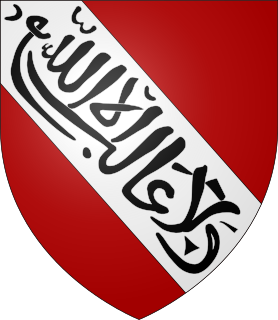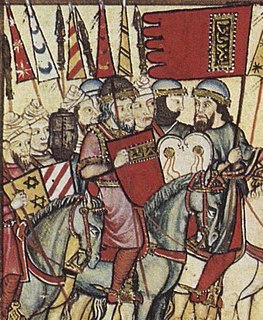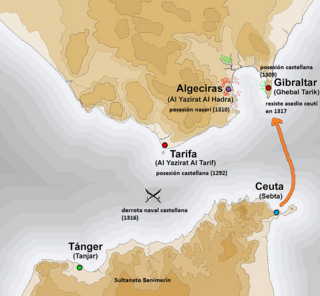Related Research Articles

The Nasrid dynasty was the last Muslim dynasty in the Iberian Peninsula, ruling the Emirate of Granada from 1230 until 1492. Its members claimed to be of Arab origin. Twenty-three emirs ruled Granada from the founding of the dynasty in 1230 by Muhammad I until 2 January 1492, when Muhammad XII surrendered all lands to Queen Isabella I of Castile. Today, the most visible evidence of the Nasrid dynasty is part of the Alhambra palace complex built under their rule.

The Battle of Jerez took place in 1231 near the southern Spanish city of Jerez de la Frontera during the Reconquista. King Ferdinand III of Castile and León's troops fought against those of Emir Ibn Hud of the taifa of Murcia. The Castilian forces were led by Ferdinand's brother, Prince Alfonso de Molina, assisted by Álvaro Pérez de Castro; according to some accounts Castro led the Castilians, not Molina. The battle is traditionally seen as marking the collapse of Ibn Hud's authority, and allowing the rise of his successor, Muhammad I.

Abu Abdullah Muhammad ibn Yusuf ibn Nasr, also known as Ibn al-Aḥmar and by his honorific al-Ghalib billah, was the first ruler of the Emirate of Granada, the last independent Muslim state on the Iberian Peninsula, and the founder of its ruling Nasrid dynasty. He lived during a time when Iberia's Christian kingdoms—especially Portugal, Castile and Aragon—were expanding at the expense of the Islamic territory in Iberia, called Al-Andalus. Muhammad ibn Yusuf took power in his native Arjona in 1232 when he rebelled against the de facto leader of Al-Andalus, Ibn Hud. During this rebellion, he was able to take control of Córdoba and Seville briefly, before he lost both cities to Ibn Hud. Forced to acknowledge Ibn Hud's suzerainty, Muhammad was able to retain Arjona and Jaén. In 1236, he betrayed Ibn Hud by helping Ferdinand III of Castile take Córdoba. In the years that followed, Muhammad was able to gain control over southern cities, including Granada (1237), Almería (1238), and Málaga (1239). In 1244, he lost Arjona to Castile. Two years later, in 1246, he agreed to surrender Jaén and accept Ferdinand's overlordship in exchange for a 20-year truce.
Muhammad II was the second Nasrid ruler of the Emirate of Granada in Al-Andalus on the Iberian Peninsula, succeeding his father, Muhammad I. Already experienced in matters of state when he ascended the throne, he continued his father's policy of maintaining independence in the face of Granada's larger neighbours, the Christian kingdom of Castile and the Muslim Marinid state of Morocco, as well as an internal rebellion by his family's former allies, the Banu Ashqilula.
Muhammad III was the ruler of the Emirate of Granada in Al-Andalus on the Iberian Peninsula from 8 April 1302 until 14 March 1309, and a member of the Nasrid dynasty. He ascended the Granadan sultan's throne after the death of his father Muhammad II, which according to rumours was caused by Muhammad III poisoning him. He had the reputation of being both cultured and cruel. Later in his life, he became visually handicapped, which caused him to be absent from many government activities and to rely on high officials, especially the powerful Vizier Ibn al-Hakim al-Rundi.
Nasr, full name Abu al-Juyush Nasr ibn Muhammad, was the fourth Nasrid ruler of the Emirate of Granada from 14 March 1309 until his abdication on 8 February 1314. He was the son of Muhammad II al-Faqih and Shams al-Duha. He ascended the throne after his brother Muhammad III was dethroned in a palace revolution. At the time of his accession, Granada faced a three-front war against Castile, Aragon and the Marinid Sultanate, triggered by his predecessor's foreign policy. He made peace with the Marinids in September 1309, ceding to them the African port of Ceuta, which had already been captured, as well as Algeciras and Ronda in Europe. Granada lost Gibraltar to a Castilian siege in September, but successfully defended Algeciras until it was given to the Marinids, who continued its defense until the siege was abandoned in January 1310. James II of Aragon sued for peace after Granadan defenders defeated the Aragonese siege of Almería in December 1309, withdrawing his forces and leaving the Emirate's territories by January. In the ensuing treaty, Nasr agreed to pay tributes and indemnities to Ferdinand IV of Castile and yield some border towns in exchange for seven years of peace.
Abu'l-Walid Ismail I ibn Faraj was the fifth Nasrid ruler of the Emirate of Granada on the Iberian Peninsula from 1314 to 1325. A grandson of Muhammad II on the side of his mother Fatima, he was the first of the lineage of sultans now known as the al-dawla al-isma'iliyya al-nasriyya. Historians characterise him as an effective ruler who improved the emirate's position with military victories during his reign.

Abu al-Hajjaj Yusuf ibn Ismail, known by the regnal name al-Muayyad billah, was the seventh Nasrid ruler of the Emirate of Granada on the Iberian Peninsula. The third son of Ismail I, he was Sultan between 1333 and 1354, after his brother Muhammad IV was assassinated.
Abu Abdullah Muhammad ibn Ismail, known as Muhammad IV, was the ruler of the Emirate of Granada on the Iberian Peninsula from 1325 to 1333. He was the sixth sultan of the Nasrid dynasty, succeeding to the throne at ten years old when his father, Ismail I, was assassinated.

The Emirate of Granada, also known as the Nasrid Kingdom of Granada, was an Islamic realm in southern Iberia during the Late Middle Ages. It was the last independent Muslim state in Western Europe.
Abu al-Walid Ismail II ibn Yusuf was the ninth Nasrid ruler of the Emirate of Granada on the Iberian Peninsula. He reigned from 23 August 1359 until his death.
Abu Abdullah Muhammad VI ibn Ismail, also known by his Castilian nickname el Bermejo and the regnal names al-Ghālib bi 'llāh and al-Mutawakkil ʿalā 'llāh, was the tenth Sultan of the Emirate of Granada. A member of the Nasrid dynasty, he ruled for a brief period between June or July 1360 and April 1362.

Abu al-Hajjaj Yusuf ibn Muhammad was sultan of the Emirate of Granada, the last Muslim state in the Iberian Peninsula, from January 1391 until his death. He was the 11th sultan of the Nasrid dynasty and the first son of his predecessor, Muhammad V.
Muhammad VII was the twelfth Nasrid ruler of the Muslim Emirate of Granada in Al-Andalus on the Iberian Peninsula. He was the son of Yusuf II and grandson of Muhammad V. He came to the throne upon the death of his father. In 1394, he defeated an invasion by the Order of Alcántara. This nearly escalated to a wider war, but Muhammad VII and Henry III of Castile were able to restore peace.

Muhammad IX (1396–1454) was the fifteenth Nasrid ruler of the Emirate of Granada in Al-Andalus on the Iberian Peninsula. He was likely the father of Aixa.

The second siege of Gibraltar was an abortive attempt in 1316 by the forces of the Azafid Ceuta and the Nasrid Emirate of Granada to recapture Gibraltar, which had fallen to the forces of Ferdinand IV of Castile in 1309.

The Battle of Los Alporchones was a battle of the Spanish Reconquista that took place on 17 March 1452. The battle was fought between the troops of the Emirate of Granada and the combined forces of the Kingdom of Castile and its client kingdom, the Kingdom of Murcia. The Moorish army was commanded by Malik ibn al-Abbas and the Castilian troops were commanded by Alonso Fajardo el Bravo, the head of the House of Fajardo and the Alcalde of Lorca Castle. The battle was fought in the area around the city of Lorca and resulted in a victory for the Kingdom of Castile.
The siege of Almería was an unsuccessful attempt by Aragon to capture the city of Almería from the Emirate of Granada in 1309. Almería, a Mediterranean port in the southeast of the emirate, was the initial Aragonese target in a joint Aragonese-Castilian campaign aimed at conquering Granada. The Aragonese troops led by their King James II arrived on 11 August, blockading the city and employing siege engines. The city, led by governor Abu Maydan Shuayb and naval commander Abu al-Hasan al-Randahi, prepared for the siege by strengthening its defenses and stockpiling food. Throughout the siege, both sides exchanged shots from siege engines and engaged in fields battles and skirmishes with varying results. James ordered multiple unsuccessful assaults. A Granadan relief column under Uthman ibn Abi al-Ula arrived nearby in September and harassed the besiegers.
Abu Said Faraj ibn Ismail was a member of the Nasrid dynasty of Granada, who was a close advisor to Sultan Muhammad II and Muhammad III and served as the governor of Málaga between 1279 and the early 1310s. He was born in 1248 to Ismail ibn Nasr, governor of Málaga and brother of Sultan Muhammad I. After Ismail's death, the Sultan brought the young Abu Said to court, where he became friends with his cousin, the future Muhammad II. When the latter became Sultan, Abu Said became his advisor on economic and military policies. He married Muhammad II's daughter Fatima, and in 1279 he was appointed as the royal governor in Málaga. The city—the realm's most important port—had just recently been recovered by the crown after a rebellion by the Banu Ashqilula since 1266 followed by a short occupation by the Marinids of Morocco since 1278. He implemented policies to pacify the population and improved the region's economic condition, as well as embarking on the construction of ships to strengthen the Granadan navy. As governor, he also led Málaga's troops in various campaigns on the Iberian Peninsula, including against rebels and against the Marinid Sultanate.
Abu Sa'id Uthman ibn Abi al-Ula was a Marinid prince who led an unsuccessful rebellion aiming to capture the throne, and fled to the Nasrid Emirate of Granada in its aftermath. There he served as the Commander of the Volunteers of the Faith of Granada, and became one of the most important political figures of the Nasrid realm.
References
- 1 2 3 4 5 6 7 Francisco Vidal Castro, "Muhammad VII", Diccionario biográfico español (Real Academia de la Historia, 2018).
- 1 2 3 4 Francisco Vidal Castro, "Historia política", in María Jesús Viguera Molíns (ed.), El reino nazarí de Granada (1232–1492), Vol. 3: Política, instituciones, espacio y economía (Espasa Calpe, 2000), pp. 47–248, at 143.
- 1 2 3 4 5 6 7 Indalecio Pozo Martínez, "Las torres medievales del Campo de Caravaca (Murcia)", Mélanges de la Casa de Velázquez32-1 (1996), pp. 263–285, at 264 & 274.
- 1 2 3 Samuel A. Claussen, Chivalry and Violence in Late Medieval Castile (Boydell & Brewer, 2020), p. 127.
- 1 2 3 L. P. Harvey, Islamic Spain, 1250 to 1500 (University of Chicago Press, 1990), p. 221.
- ↑ Joseph F. O'Callaghan, The Last Crusade in the West: Castile and the Conquest of Granada (University of Pennsylvania Press, 2014), p. 39.